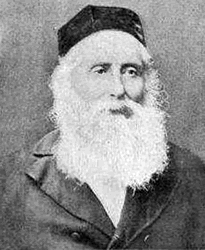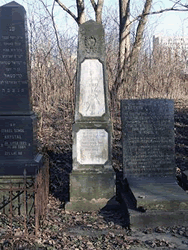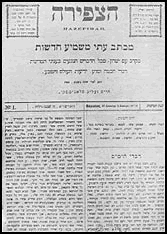Hayyim Selig Slonimski was born in Byelostok, Russian Empire (modern Bia?ystok, Poland) March 31, 1810.
When Slonimski was only twenty-four years old he finished writing a textbook on mathematics, but due to lack of funds, only the first part of which was published in 1834 under the title Mosede ?okmah.[1]
In 1835 Slonimski released Sefer Kukba di-Shebit (1835), a collection of essays on the Halley comet and other astronomy related topics such as laws of Kepler and Newton. This work significantly increased Slonimiski's popularity, because Halley's comet was widely discussed topic as the return of this periodic comet was expected in 1835.[2]
In 1838 Hayyim Selig Slonimski settled in Warsaw, where he became acquainted with mathematician and inventor Abraham Jacob Stern (1768–1842), later becoming his son-in-law, when in 1842 he married Stern's youngest daughter, Sarah (1824–1897).
In 1844 he was awarded the part Demidov Prize of 2,500 rubles by Russian Academy of Sciences for the invention of a calculating machine.[3] Slonimski lived between 1846 and 1858 in Tomaszów Mazowiecki, an industrial town in central Poland. In 1853 he invented a chemical process for plating iron vessels with lead, and in 1856 an electrochemical device for sending quadruple telegrams. The system of multiple telegraphy perfected by Lord Kelvin in 1858 was based on Slonimski's discovery [4]
In deciding certain scientific questions connected with Jewish matters, Slonimski at times found himself at variance with other Jewish scholars. Thus, despite his conservatism, he admitted that an error of four days' excess had crept into the Hebrew calendar cycle as compared with the true solar cycle; in this view he was opposed especially by Joseph Perles, the controversy being carried on for thirty years. Slonimski likewise discussed the question of the so-called "Jewish date-line" for deciding on which days Shabbat and holy days should be observed by Jews in the Far East and in Australasia. He argued that for them the line must be fixed not from Greenwich, but from Jerusalem, the center of the earth according to the Talmud. This calculation would make the dividing line pass between China and Japan, the former with the Philippines being included in the Far East, and the latter in the West .[4]
In 1862 in Warsaw Slonimski established weekly newspaper Ha-Tsefirah, which was the first Hebrew organ devoted mainly to scientific subjects.[5][4] It was published for six months until the same year Slonimski was appointed as principal of the rabbinical seminary in Zhytomyr and as government censor of Hebrew books, positions which he held till the seminary was closed by the Russian government in 1874 .[4]
Slonimski resumed the publication of Ha-Tsefirah at Berlin the same year, changing the place of publication to Warsaw in September 1875.
Hayyim Selig Slonimski died in Warsaw on May 15, 1904.
Slonimski's grave at Warsaw Jewish Cemetery
[] Major works
Mosede ?okmah (1834), on the fundamental principles of higher algebra
Sefer Kukba di-Shebit (1835), essays on the Halley comet and on astronomy in general
Toledot ha-Shamayim (1838), on astronomy and optics
Yesode ha-'Ibbur (1852), on the Jewish calendar system and its history
Me?i'ut ha-Nefesh we-?iyyumah (1852), on of the immortality of the soul
Ot Zikkaron (1858), a biographical sketch of Alexander von Humboldt
[References
![]() This article incorporates text from the 1901–1906 Jewish Encyclopedia article "Slonimski, ?ayyim Selig" by Isidore Singer and Judah David Eisenstein, a publication now in the public domain.
This article incorporates text from the 1901–1906 Jewish Encyclopedia article "Slonimski, ?ayyim Selig" by Isidore Singer and Judah David Eisenstein, a publication now in the public domain.
^ Israel Zinberg (1978) The Haskalah Movement in Russia, p.180
^ Israel Zinberg, The Haskalah Movement in Russia, p.180
^ Chaim Aronson, Norman Marsden (1983) A Jewish Life Under the Tsars: The Autobiography of Chaim Aronson, 1825–1888 Oxford Centre for Postgraduate Hebrew Studies, p.310
^ a b c d JewishEncyclopedia.com - SLONIMSKI, ?AYYIM SELIG: at www.jewishencyclopedia.com
^ Israel Zinberg The Haskalah Movement in Russia, p. 179. "The basic purpose of Ha-Tzefirah", Slonimski <...> announced in the prospectus of the journal which he circulated in January 1862,"is to spread the light of the necessary sciences, to demonstrate their beauty and utility".
[] External links
Sketches of Jewish Life in Russia by Chief Rabbi Dr. Lilienthal: Chajim Selig Slonimski, the Mathematician
View page ratings
Rate
Chaim Zelig Slonimsky
by A.S. Hirshberg
Translated by Daphna Brafman Coordinated by Tilford Bartman
Chaim Zelig Slonimsky was born close to the end of winter of 1810. His father, R. Ya'acov son of Rabbi Binyamin Bishke, was a scholar; they used to call him R. Yankeleh Slonimer because his origin was from Slonim.
Chaim Zelig Slonimsky is the grandson of R. Yekhiel Neches, founder and owner of Beit Hamidrash (house of study/academy) in the Jewish Street in Bialystock, and it is named after him.
Chaim Zelig had the tendency for the study of mathematics and sciences. He dealt with these studies all his life. At first he studied engineering and mathematics from Hebrew sources: from books written by Jewish experts like Raphael Hannover and like R. Shimon Walsh's commentary on some of the Rambam's writings. Later he learnt the German language with the help of Michel Zabludowski who became his friend and supplied him with German science books. Chaim Zelig secretly studied in Beit Hamidrash and did very well.
His first wife came from Zabludow. In that town he wrote his first project in Hebrew. It's title was " Foundations of Wisdom", and it was published in Vilnus with the generous help of Moshe Rosental, and the consent of his friend R' Avely. R' Avraham Zakheim funded the printing of his book "Stars of The Comet" in Vilnus in 1834. Many were interested in that subject because they expected the appearance of a comet.
In 1834 he printed his book " Chronicles of The Skies" in Warsaw. His book " Foundations of Conception" was translated into German and English.
In 1844 he invented the calculation machine. He received an award of 2500 rubles from the Czarist academy and crowned with the title "A Learned Citizen".
While visiting Berlin in 1858 he met Alexander Von Homboldt who introduced him to the Prussiam king. Chaim Zelig wrote a tribute book for Alexander Von Homboldt- " Chronicles of His Life, Journeys and Books". The rich of the Berlin community covered the expenses for that book.
Russia and Poland's Jewry greatly appreciated his personality. The young students of Beit Hamidrash were strongly impressed by his science books that were written in a popular, modern and beautiful language. He encouraged them to study sciences. They called him " the Jewish Homboldt".
In 1856 he invented a system for sending telegrams through electric flow. In 1862 he began to publish the weekly magazine "Hatsfirah"*. A short time later Hatsfirah became a daily newspaper. Nahum Sokolov participated in it.
On the 37th issue of Hatsfirah Chaim Zelig Slonimsky tells about his studies in his old man's Beit Hamidrash. He studied Gemara there, first and last Poskim. He also became a friend with one kabbalist, the old R' Moshe, who had studied Kabbalah books and commentaries.
At the age of 17 Chaim Zelig married a daughter of Zabludow and there he met another Kabbalist. He was impressed by that man, who was well known and appreciated, and he wanted to be his student. Unfortunately he did not make it because the man died shortly after Chaim Zelig arrived in town.
His book "The Reality of The Spirit and It's Out of Body Existence" won him the friendship of many pious men. He died in Warsaw in 1904. Zabludow city council named a street after him.


